
Courtesy of Isaac Julien
“Migrating Worlds: The Art of the Moving Image in Britain” is the Yale Center for British Art’s first exhibition dedicated exclusively to film and video.
On view until Dec. 29, the exhibition highlights 10 works by Britain’s leading film and video artists. It features Theo Eshetu, Isaac Julien, Rosalind Nashashibi, Charlotte Prodger, Zina Saro-Wiwa, Zineb Sedira, John Smith and Alia Syed.
“The exhibition is exciting, and I think it challenges perceptions about what the center is as a museum and what it can be,” said Matthew Hargraves, chief curator of art collections at the YCBA and curator of the exhibition.
The exhibition is the result of collaboration between Hargraves and Rizvana Bradley, assistant professor of the history of art and African American studies. It was also supported by the YCBA’s former director, Amy Meyers.
Hargraves said that much of Britain’s “compelling” modern art is in moving image. The exhibition emerged from a “long-standing desire” to represent works of this medium at the YCBA.
According to the YCBA Director Courtney Martin, film, video and time-based media are “crucial” to contemporary art. Avant-garde artists began experimenting with these mediums in the early 20th century.
According to the exhibit’s press release, the exhibition addresses issues such as “forced migration, race and gender identity, environmental destruction, and colonial history.” Hargraves and Bradley worked closely with the featured artists to decide which of their works would best suit these themes.
Hargraves said that while some installations are immersive and poetic, other installations are more conceptual. He added that each element of the exhibition reflects “the movement of people across and around the world and the impact of those movements on questions of identity.”
Each artist has their own space in the exhibit. While the majority of the exhibition is situated on the YCBA’s third floor, a few works are displayed in other spaces such as the Entrance Court. Yet installing some of works in the YCBA posed spatial difficulties, Hargraves said.
“We had to think carefully about the way the work would fit into our building, which is not ideally suited to moving image,” Hargraves said. “Some [artists] even came to visit the center to see the space in order to make more informed decisions.”
Martin said the featured artists are significant in their own right, and the exhibition makes clear the YCBA’s capability to show both historic and contemporary art in equal measure.
For Hargraves, the exhibit provides a broad perspective on “fundamentally relevant” current issues concerning communities across the world, including current presidential campaigns in the United States and Europe.
“The movement of people is one of the most pressing political issues of our time,” Hargraves said. “The exhibition seeks to take a longer view, to see patterns of movement over time, to explore the historical causes and effects, to consider how those have shaped the world today from the way we see ourselves and to the way our environment has changed as a result.”
The exhibit coincides with the release of “Artists’ Moving Image in Britain Since 1989.” The book, published by Yale University Press and the Paul Mellon Centre for Studies in British Art, was edited by Erika Balsom, Sarah Perks and Lucy Reynolds.
Freya Savla | freya.savla@yale.edu







